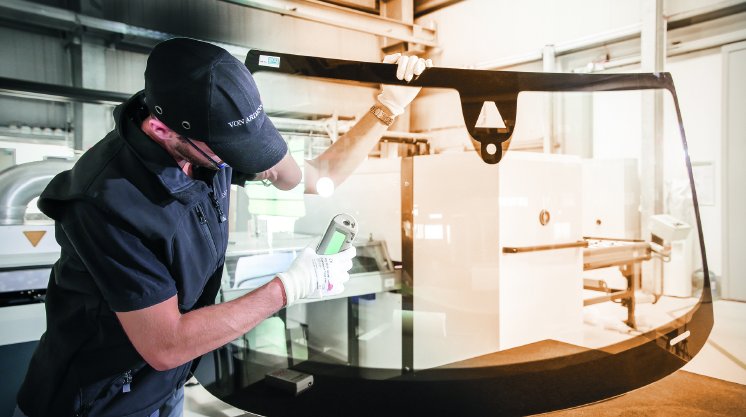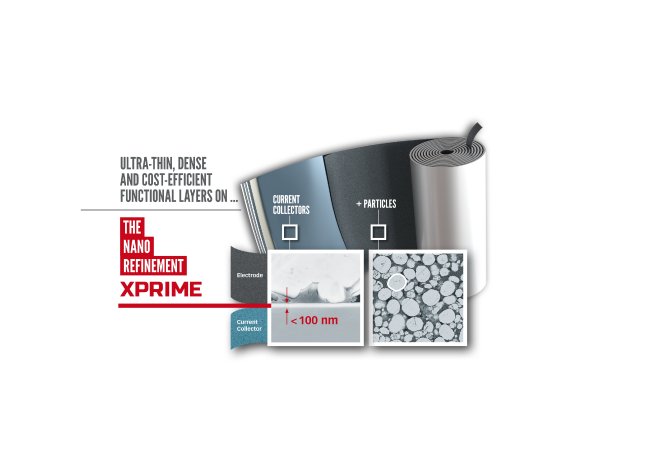During the New Mobility World at the IAA 2019 in Frankfurt, Germany, VON ARDENNE will introduce its latest developments for the future of mobility, such as innovative solutions for lithiumion batteries and fuel cells, automotive glazing, displays or sensor technology. VON ARDENNE will show how ultra-thin coatings will provide materials with new functional surface properties and contribute to saving and storing energy and why they enable certain highly advanced electronics in the first place.
High-performance and cost-efficient lithium-ion batteries with the help of PVD coatings
High output, high energy density, longevity, fast-charging capacity as well as a sustainable and resource-saving manufacturing process: all these are requirements imposed on modern lithium-ion batteries and their production. With XPRIME, a specially developed physical vapor deposition (PVD) technology, VON ARDENNE offers a suitable solution. XPRIME is an ultra-thin (<100 nm) carbon coating on aluminum or copper current collectors. This coating increases the conductivity of the current collector and, thereby, reduces the through-plane resistance between the current collector and the electrode coating. The result is an increased power density and the lifetime of the battery cell.
XPRIME enables the passivation of the current collector and increases its electro-chemical stability, which is needed in highvoltage or all-solid-state batteries. Furthermore, the technology increases the chemical stability against corrosive media the current collector might be exposed to due to improper storage or during a water-based electrode production.
Bipolar plates with a carbon coating for fuel cells
Fuel cells have a high potential to ensure the mobility of tomorrow. Essential components of fuel cells are bipolar plates. Today, most of these bipolar plates are made of graphite and have good physical and chemical properties. However, the thickness of the material, the high production costs and the sensitivity to vibration hinder their commercial success.
Stainless steel bipolar plates could be an alternative. They are not sensitive to vibration, are intrinsically gastight, affordable to produce and much thinner than their graphite counterparts.
However, it is very challenging to provide them with the physical and chemical properties that are comparable to those of graphite bipolar plates. The obvious solution would be a gold coating, but that would ruin the cost advantage.
VON ARDENNE has succeeded in depositing a carbon coating on stainless steel bipolar plates using physical vapor deposition (PVD). The carbon coating had similar properties to a gold coating with regards to its interfacial contact resistance (ICR), adherence and corrosion resistance. As a result, VON ARDENNE offers an ideal solution for a low-cost production of high-performance bipolar plates. Furthermore, the company offers the matching equipment platforms for fields of application ranging from research and development task to high-volume industrial coating.
Energy-efficient glazing for vehicles with the help of infrared reflex coatings
The proven technologies and systems for large-area glass coating, a field in which VON ARDENNE has been a leading provider for more than 15 years, also offer certain crucial benefits for applications in automotive glass coating. High-performance coatings help reduce energy consumption and increase comfort and safety for drivers and passengers. For instance, infrared reflex (IRR) coatings on windshields and glass roofs prevent the interior from heating up too much, which reduces the need for air conditioning. This results in lower consumption and emission for vehicles with combustion engines or an increased range for electric vehicles. Beyond that, low-emissivity (Low-E) and antireflection (AR) coatings help increase the comfort in vehicles.
High-value functional coatings for displays and sensors
Analog controls and instruments are already being replaced by larger electronic displays and the demand for them is rising. Therefore, the requirements imposed on the quality and the homogeneity of antireflection coatings for displays are rising along with this demand so that irritating reflections or color variations can be avoided. Furthermore, the touch functionality causes fingerprints, which can be removed more easily from displays if they have an easy-to-clean coating. With VON ARDENNE equipment, it is possible to deposit coatings with both functions in just one step – a fact that increases the longevity of the coating tremendously and makes their creation very efficient.
In head-up displays, however, reflections are desirable and are created deliberately to project information on a large area of the windshield. To create a brilliant and non-distorted image, it is necessary to use beam splitters and highly reflective mirrors that would not be possible without extremely precise and ultra-thin coatings.
The future of mobility will increasingly be determined by complex sensor technology that is indispensable for autonomous driving, safety, comfort and engine control. Many of these functions require precise coatings, such as optical filters for LIDAR sensors for distance and speed control. Beyond that, pressure sensors for fuel-injection or micro-electromechanical systems (MEMS) and semiconductor elements, which are used extensively in vehicles, require various coatings consisting in part of several materials.
For all these applications, VON ARDENNE offers the suitable coating technologies and equipment, which meet the high requirements of the industry and enable a low-cost production.
Solar power for electric vehicles: photovoltaics solutions for new mobility
The growth of electric mobility goes hand in hand with the expansion of renewable energies. No matter if it is about photovoltaic modules for solar parks, rooftops or for the integration into buildings and vehicles: VON ARDENNE offers suitable solutions for the cost-efficient mass production of efficient solar cells thanks to its role as a leading provider of coating technologies and equipment. The German high-tech company has expertise in both thin-film and crystalline photovoltaics.


